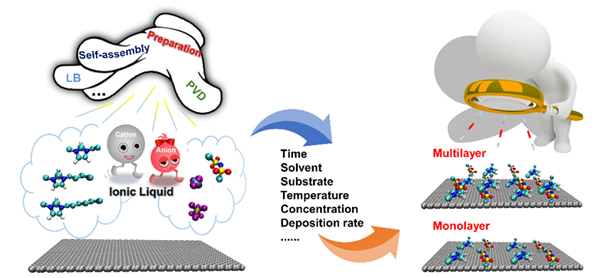摘要/Abstract

由于阴阳离子间特殊的静电、氢键作用, 具有二维结构的离子液体呈现出独特的结构特征及热力学、动力学特性, 在化学化工和材料领域都有着巨大的应用前景, 已成为离子液体领域重要的研究方向之一. 本综述重点介绍了离子液体二维结构常用的制备方法, 包括自组装法、Langmuir-Blodgett法以及物理气相沉积法, 并总结了这些制备方法相应的优缺点. 随后归纳了离子液体二维结构的相变特征及在力学和电学方面的特性, 并综述了其在摩擦润滑领域的应用. 最后展望了离子液体二维结构的发展方向及应用前景.
关键词: 离子液体, 二维结构, 制备方法, 相变, 力学/电学特性
As green alternatives to non-environmental reagents, ionic liquids (ILs) have brought about a revolution in green chemical engineering. Very recently, attention to interfacial ILs has arisen. As a new structural type of ionic liquid, the ionic liquid (IL) with two-dimensional structure is endowed with unique structural features, thermodynamic and dynamic characteristics due to its special electrostatic and hydrogen bonds. It shows excellent application prospects in the field of chemistry and materials and has become one of the important research directions in the field of ILs. The standard preparation methods of two-dimensional structure ILs, including self-assembly, Langmuir-Blodgett and physical vapor deposition (PVD) methods are introduced in this review. The advantages and disadvantages of each method are also summarized. Self-assembly is the easiest and most widely used method to prepare two-dimensional ILs and the obtained structure is stable at room temperature. Meanwhile, the two-dimensional structure can be regulated by choosing different polar solvents and solutions with different concentrations. Langmuir-Blodgett method is suitable for polyionic liquids and amphiphilic ILs, because it requires monolayer IL to be formed on the water surface. PVD is mainly for ILs with high stability in the heating process under vacuum conditions, through which precise regulation of two-dimensional ILs structure can be achieved at ion level. However, the structure is sensitive to temperature, and temperatures higher than 100 K will destroy it. Then we review the phase transition feature, mechanical and electrical characteristics of two-dimensional structure ILs, including the lubrication applications. The enhanced surface effect results in the liquid-solid transition of ILs and the tendency of solidification is stronger when approaching the solid surface. On one hand, the conductivity decreases drastically with decreasing the thickness of two-dimensional ILs structure due to solidification. On the other hand, the solidification contributes to better lubrication performance with stronger resistance to friction and wear. Finally, the future development and broad application of two-dimensional structure ILs are envisioned.
Key words: ionic liquid, two-dimensional structure, preparation method, phase transition, mechanical/electrical property
PDF全文下载地址:
点我下载PDF
